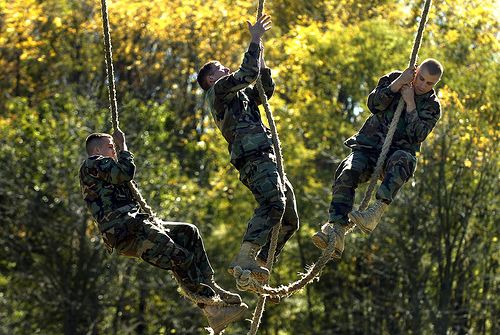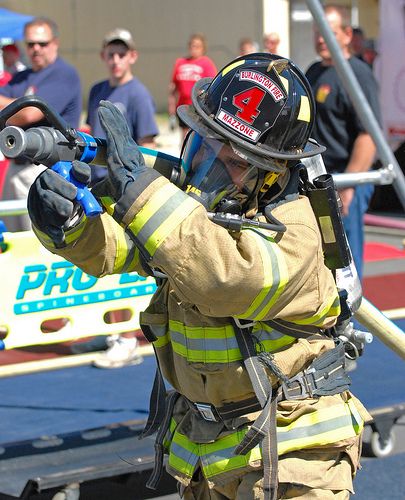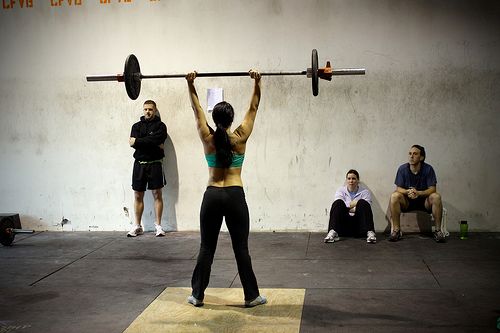Modern Fitness Standards: How Do You Measure Up?
Welcome Stumblers and all newcomers! If you want to lose weight, gain muscle, increase energy levels, reduce stress or just generally look and feel healthier you've come to the right place.
Subscribe to my free weekly newsletter for tips, advice and special insider-only information.
Learn more about the Primal Lifestyle by visiting the Primal Blueprint 101 page. Thanks for visiting!
 (This is the third part of a four part series on fitness. Part 1: What Does it Mean to Be Fit?, Part 2: Could You Save Your Own Life?)
(This is the third part of a four part series on fitness. Part 1: What Does it Mean to Be Fit?, Part 2: Could You Save Your Own Life?)
Organizations whose members are expected to engage in physical activity as an essential aspect of affiliation – the various branches of the military, law enforcement agencies, fitness methodologies like CrossFit – necessarily impose standardized fitness benchmarks, minimum requirements which every prospective member must satisfy. When a significant portion of your professional identity is predicated upon your ability to catch (or kill) bad guys (bad guys, mind you, whose primary objective is to avoid capture), you’ve got to be able to run, jump, support your own body weight, and adequately perform all the other physical activities that might come up in a day’s work. The various fitness standards are an attempt to ensure candidates are up to par in their respective areas.
They vary wildly, of course. Different jobs call for different levels of competency. Also, certain organizations, like the Army, are always looking for new recruits, so their standards aren’t quite as rigorous when compared to the Navy SEALs’ standards. There’s a high demand for entrance into the SEALs, and they do their best to dissuade casual applicants; while it would certainly be nice if the Army were populated entirely by SEALs, it isn’t realistic. Thus, the Army has “relaxed” standards.
I wonder, though, if any of these benchmarks are suitable for the general public. Should the average adult be fit enough to become, say, a police officer? A marine? A SEAL? Let’s take a look at a few.
The Utah Peace Officer Standards and Training (POST) certification requires prospective Utah County police offers to complete the following:
- 1.5 mile run in 15:37
- 16 reps of consecutive pushups with no rest
- 15 inch vertical jump
- 25 sit-ups in a minute
- 300 meter run in 70 seconds
No pull-ups? Pretty mild standards, if you ask me, but I’m probably biased. I bet many of you could pass that test without breaking much of a sweat. Still, a fair amount of “average” adults probably could not. And anyway, that’s the just the first test. If you barely pass that, police academy should whip you into shape.

The Marine Corps Physical Fitness Test (PFT) is tougher and must be performed once a year, so you can’t exactly slack off with it. There’s also a Combat Fitness Test (CFT) to be completed, which is geared towards functional battlefield fitness. Males receive five points for every pull-up, one point for every crunch, and one point is deducted from 100 for every 10 seconds slower than 18 minutes on the three mile run. Females receive 1.5 points for every second on the flexed arm hang (maximum 70 seconds), while the scoring is the same for crunches and the three mile run (although they get 21 minutes for the run). To earn a perfect PFT score of 300, males must do 20 consecutive pull-ups, 100 crunches in less than two minutes, and complete the three mile run in at least 18 minutes. For females, it’s 70 seconds on the flexed arm hang, 100 crunches, and 21 minutes. Bare minimums, though? A male can get by with just a few pull-ups, 50 crunches, and a 28 minute run time; a female can get by with 15 seconds on the hang, 44 crunches, and a 30 minute run time.
The SEALs require even more general fitness competency, and that’s just for the initial Physical Screening Test (PST). The numbers listed are absolute minimums, with the understanding that they are to be exceeded. A guy who just barely hits the minimums will have technically passed, but there’s no way he realistically makes it further.
- 500 meter swim using breast stroke or a modified freestyle (called Combat sidestroke) in 12:30, competitive time of under 10:30
- 42 push-ups in two minutes, competitive count of at least 79
- 50 sit-ups in two minutes, competitive count of at least 79
- 6 consecutive dead hang pull-ups, competitive count of at least 11
- 1.5 mile run in “boots and trousers”in under 11:30, competitive time of under 10:20
Once you pass the PST, there’s an additional three-phase, 27-week long training course that really weeds ‘em out.

How about firefighters? Of all the official standardized fitness tests for service personnel, I like the physical ability test in the Basic Firefighter Certification most. Different states have different requirements, but they’re generally more strenuous than the law enforcement and military tests (save for the SEALs and other special forces). Take the Seattle Fire Department’s Candidate Physical Ability Test. Applicants must wear long pants, a safety helmet, gloves, and a 50 pound weighted vest while completing the following in consecutive order with very little rest in between exercises:
- Stair climb – while carrying two additional 12.5 pound shoulder weights, candidates must climb a stairmaster at level three (50 steps per minute) for 20 seconds, then three minutes at level four (60 steps per minute)
- Hose drag – placing the 1.5 inch nozzle over their shoulder, they must drag a 200 foot hose past a barrel 75 feet distant, make a 90 degree turn and pull the hose 25 more feet; then, pull the hose hand over hand for fifty feet
- Equipment carry – carry two heavy power saws 75 feet to a marker and back
- Ladder raise and extension – flat raise a 24 foot aluminum extension ladder, hand over hand, until it’s standing; extend a 24 foot ladder hand over hand, then lower it in a controlled motion
- Forcible entry – strike the “Forcible Entry Cumulative Force Measure Device” with a horizontal swing of a ten pound sledgehammer without rest for several minutes
- Search – blind, crawl through a tunnel maze and maneuver around, under, and over various obstacles to emerge from the exit
- Rescue – pull a 165 pound dummy for 35 feet, then turn around and return to the starting position
- Ceiling breach and pull – use a six foot pole to push up a weighted, 60 pound section of ceiling three times, then hook the pole to a weighted ceiling resistance device and pull down five times; repeat this sequence for four sets
What I like about this test (beyond just the weighted vests and general intensity) is that it’s entirely functional, and not just for firefighters. These are activities that anyone would find useful – dragging someone to safety, climbing stairs with extra weight on one’s shoulders, crawling blind through tunnels, dragging heavy objects, raising a ladder. You could probably drop your gym workouts and do nothing but this test a few times a week, and you’d be in fantastic shape.
Then there are the sports-specific standards. A decathlete is expected to show aptitude in ten track and field events: 100 meter dash, long jump, shot put, high jump, 400 meter dash, 110 meter hurdles, discus throw, pole vault, javelin, 1500 meter run. Sprinting, jumping, leaping, endurance, power, strength – you can’t get much more balanced than that.
Football and basketball draft combines attempt to grade athletes based on standardized physical tests and drills.
Football players must complete:
- 40 yard dash for time
- 20 yard short shuttle run (twice) for time
- Vertical jump
- 225 lb bench press, maximum reps
Basketball players must complete:
- No step vertical jump
- Maximum vertical jump (step allowed)
- 185 lb bench press, maximum reps
- 3/4 court sprint
There are different expected scores for different positions, weights, and heights, of course, but both combine drill sets attempt to quantify and measure the type of activities (jumping, sprinting, pushing) players will make on the court.

And then there are the benchmarks of pure fitness methodologies, like CrossFit. CrossFit is interesting in that it ordains no strict, precise, objective benchmarks. They don’t tell their members to hit a certain weight on the squat, or a minimum time on the rower. Instead, they preach general proficiency in all areas of fitness: “cardiorespiratory endurance, strength, stamina, flexibility, coordination, agility, balance, accuracy, power, and speed.” Athletes are free to set their own personal benchmarks, whether it be completing a strict bodyweight overhead press, or rowing 2000 meters in under seven minutes. They are encouraged to complete the scheduled workout of the day (WOD), though, which allows athletes to compete against each other (or themselves).
For my money, this is the way to do it, especially compared to the way military and law enforcement test their recruits. CrossFit (and other similar fitness methodologies) is constantly evolving, and its athletes evolve along with it. There’s always that drive to best your personal benchmarks, to improve and to grow. Typical fitness tests, on the other hand, are usually one-shot deals; a police recruit could conceivably train just enough to pass the entrance exam, only to go to pot once he’s embedded in the force and comfortable with his place (funnily enough, CrossFit is hugely popular with police, military, and firefighters).
Now, I think CrossFit is on the right track, but it’s not for everyone. The overall, well-rounded approach to fitness is generally superior, though, (for most people’s purposes, which do not include dunking on a ten foot hoop or catching a touchdown pass) to the sport-specific training. Does the average person need to be able to complete the WOD in record time? No, absolutely not, but he or she should be able to squat down to pick up their kids, pull themselves up into a tree (using their feet, if need be) to climb around, go for a quick run with the dog, lift a heavy suitcase overhead, walk up several flights of stairs without breathing hard, and swim without sinking.
Or, as legendary strongman Earle Liederman once wrote, there are five fitness benchmarks that any man (or woman, with some modifications; Liederman wrote this in the not entirely enlightened 1920s) possessing adequate fitness should be able to do:
“Every man should be able to save his own life. He should be able to swim far enough, run fast and long enough to save his life in case of emergency and necessity. He also should be able to chin himself a reasonable number of times, as well as to dip a number of times, and he should be able to jump a reasonable height and distance.” (Liederman, Endurance)
Which works out to, at the very least:
- 1/2 mile swim
- 200 yard run, at full sprint speed
- Ability to jump over waist-high objects
- 15-20+ pull-ups
- 25+ dips
These are basic life skills that everyone, for the most part (age, injury, fitness level, and illness all play a role in determining things, of course – but they are good benchmarks to shoot for), should be able to perform. When you’re able to traverse your environment (vertically and horizontally), manipulate your weight, and lift things overhead without excessive effort, you’re suddenly able to enjoy life a bit more easily. You go on a long hike and, rather than sucking wind and cursing your decision to embark on the journey, you’re instead able to appreciate the sights, sounds, and smells of nature. Life shouldn’t be hard work unless you make it so. Everyday activities shouldn’t be struggles. Basic fitness should be like breathing – it should be second nature.
What do you folks think? Are there fitness absolutes? Is it enough to perform basic activities without struggling with your own body, or should Primal fitness standards reach for something more?
Additional resources:
Mark Rippetoe’s barbell strength standards – a very helpful guide for charting your progress on the major barbell lifts.

Ingen kommentarer:
Legg inn en kommentar